Dates
| 2025 League Dates | Start | End |
|---|---|---|
| Season 1 | January 4 | March 16 |
| Season 2 | April 12 | June 15 |
| Season 3 | July 5 | September 7 |
| Season 4 | September 27 | December 7 |
Code of Conduct
The mission of The World Knife Throwing League® (WKTL®) is to promote competition through sportsmanship and fair play. Our leagues/events should be played in a sportsmanship-like manner. Although competition may become intense, we expect our participants to maintain a high degree of sportsmanship up to and after the final throw.
As a participant or spectator in any WKTL® tournament or event, you pledge to:
- Respect the game, play fairly and follow all rules and policies.
- Accept & respect the decisions of WKTL® officials.
- Demonstrate good sportsmanship before, during, and after games, win or lose.
- Be responsible for the sportsmanship of teammates and assist in maintaining a respectful environment for all participants.
- Be courteous to opposing throwers, teams, officials, spectators, monitors, or facilitators and treat all throwers and officials with respect.
- Help to maintain and keep all equipment and conditions at the facility in good condition.
- Obey all facility rules, while respecting all equipment, common areas, playing areas, parking areas, and surrounding neighborhoods.
- Not to engage in discriminatory behavior based on, but not limited to: race, religion, creed, language, gender identity, or sexual identity.
- Refrain from the use of abusive language or profanity. Including but not limited to: contemptuous, discriminatory or denigratory words or actions concerning race, language, religion, gender, or sexual orientation
- Not engage in any behavior which would endanger the health, safety, or well being of any thrower, official, staff member, or spectator.
- Not use alcoholic beverages at any location unless permitted by the facility/venue.
- Not allow, use or encourage illegal drugs at any location.
- Wear/use all required and issued equipment and/or uniforms.
- Under no circumstances are live targets allowed. No thrower is to throw a knife at a target while there is a person or live object in between or in front of the thrower.
- Any verbal or non-verbal intimidation, threats of physical violence, trash talk, abusive language, profanity, threats, or general disrespect during any league or tournament towards any presiding Certified Judge, WKTL® Official, thrower or spectator will not be tolerated and will result in the immediate removal from the league or tournament.
Sportsmanship
Sports are filled with judgment calls and, as a result, disputes may occur from time to time. However, it is important that participants must handle all disputes that may occur in a constructive manner. WKTL® has the sole discretion to investigate all evidence available to maintain the integrity of the rules & the sport in any match. Protests for thrower eligibility or rule misapplications/misinterpretations are time-sensitive and must be made before the next throw. Non-throwers do not have the right to argue or challenge any calls made by a sanctioned Judge.
All decisions made by on-site WKTL® Officials must be respected and obeyed. Any feedback regarding rules, throwers, officials, or staff members should be brought to the attention of WKTL® via email.
Any behavior deemed unacceptable by WKTL® officials, presiding Judges or Affiliate owners may result in a verbal warning, ejection, suspension, and/or expulsion as outlined below. Repeated Code of Conduct violations by the same Thrower could result in expulsion from WKTL® sanctioned events without refunds.
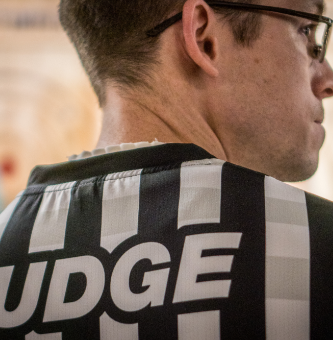
Disciplinary Procedure
All Code of Conduct violations during and outside of matches will result in disciplinary measures.
Upon an offense requiring disciplinary action, it is recommended that the presiding official issues disciplinary action in this order:
- The offending thrower will first receive a verbal warning.
- Should a similar offense occur then the throwers most recent match points will be brought to 0 and the match will count as a loss.
- Upon a third offense by the same thrower, then the offending thrower will be suspended from the season or tournament.
Pending a formal investigation, WKTL® reserves the right to suspend the thrower or spectator in question for a minimum of 6 months.
Presiding officials are not required to follow disciplinary measures in this order.
Gameplay Rules
Section A: Safety
- Injuries
- If an injury occurs, resulting in a pause in play, a thrower must be assessed by a Judge or onsite medical professional.
- If the thrower is assessed and able to continue, then the paused match may continue.
- If injured during league, a thrower is deemed to be unable to finish the remaining matches, a thrower may make up their matches the following league night with no penalties.
- When a match has not been completed and an injury occurs, the make up match will restart from throw 1.
- If an injury occurs in a tournament and the thrower is deemed unable to compete due to injury, any pending throws will be marked as 0 points and future matches forfeit.
- If an injury occurs, resulting in a pause in play, a thrower must be assessed by a Judge or onsite medical professional.
- Throwing
- Knives shall never be thrown when a participant is picking up their knives from the target area or when a Judge is in the lane. This will result in an immediate disqualification (counted as a loss) for that match and may be subject to additional disciplinary action.
- Spectators
- All non-throwing participants and spectators must be to the side of the lane or at least 5ft behind throwers.
- Headphones
- No equipment that emits sound or provides active noise cancellation (ANC), such as headphones or ANC earplugs/earbuds, may be used while throwing.
- Exceptions will be made for medical devices.
- Throwers are required to inform the lane judge that they are wearing earplugs and/or a hearing device, and may need additional accommodations such as showing the score on the tablet between throws.
Section B: Pre-Game Rules
Minimum Age
WKTL® does not enforce any age requirement or limit. Each affiliated location is allowed to have an age requirement if they so choose. Please contact your local participating league location to inquire about their age rules.
Competitors under the age of 18 may name a representative to speak on their behalf. The representative is only able to challenge calls for the said competitor. Each representative is to be named before the start of the league/tournament. The representative is expected to follow all rules of play as if they were the competitor.
Knife Quality
- Each player should check their knives to ensure no damage that may cause an injury is present.
- Before the start of a match, judges should identify the knife tip on each of the players knives (see Section D; Technicalities; 1.b.i). Players may mark their knives to help identify the tip edge so that when the knife is scored, the tip can be easily identified by the judge.
Target Quality
- Targets should be of sound quality before gameplay starts.
- Boards all must be individually secured and not able to slide or lift off from the target during sanctioned events.
- Before the start of a match, target boards should be switched out (at the Judges discretion with or without a throwers request) if the boards have deteriorated to a point where:
- excessive movement or ‘wiggling’ of the knife occur when they land in the damaged area, causing or risking good throws to fall out.
- lines of scoring areas are missing significant gaps.
- the integrity of the target rings is misshapen to the point that the target rings are greater than ⅛ inch larger or smaller than the original target.
- Board changes cannot take place during a match.
- Board changes may take place before or after a 10 throw match.
- If boards have deteriorated during a match, a thrower may request an evaluation by the Judge after the match has ended.
- Should the boards be evaluated as excessively deteriorated, a Judge may opt to change lanes. If a lane is not available – a change of target boards may occur.
- If a lane or board is changed, throwers will not be granted additonal practice throws.
- No one other than the presiding match Judge may alter the boards before, during, or after any match unless authorized by that individual. This includes, but is not limited to pulling out pieces of boards, and chopping or softening the board.
- Watering a board is not considered an alteration.
- Boards may only be watered by a thrower before the start of the match.
- Violation of this rule by a thrower results in a 0 for their next throw. If this occurs during or after the last throw of a match, the action will be considered a violation of the Code of Conduct.
- Violation of this rule by anyone other than a thrower will be considered a violation of the Code of Conduct.
- Watering a board is not considered an alteration.
Warm Up Throws
- The number of warm-up throws allowed applies to all WKTL® sanctioned leagues and tournaments.
- Throwers may have up to 3 practice throws before their first match.
- Throwers may have 1 practice throw before any subsequent match.
- Throwers may have 1 practice throw between match games in the case of a best 2/3 match set.
- Throwers are not allowed additional practice in empty lanes between matches for any sanctioned tournaments unless otherwise approved by a Tournament Host or presiding WKTL® Judge, and made available to all throwers.
- The presiding official will notify throwers when their match will commence.
Section C: Gameplay
Gameplay
- Each league week allows every participant 4 matches.
- Subject to league numbers and attendance, each match is played against different opponents, selected at random, and consists of the following:
- Each match consists of 10 throws.
- Throwers must switch sides after 5 throws.
- This ensures fair play when there are varying densities in wood.
- These 5 throws are broken into two sets of throws
- The first set consists of throwing 3 knives
- The second set consists of throwing 2 knives
- Once all knives are stationary and scored by the Judge, including the opposing thrower’s knives, throwers retrieve their knives at the end of each set of throws
- After 5 knives have been scored, then both throwers switch targets.
- Starting targets will be determined by random selection initially made by the app.
- The winner of the match will be the person with the most points after 10 throws. If there is a tie after 10 throws, there will be sudden death. Section D, 4 for details.
- The match points and win/loss then be recorded and uploaded to the leaderboards.
- After 7 weeks, the 8th and final week of each season will be the playoffs and final match to determine the season champion. See Section L: Playoffs for details.
- Each official league run by a knife throwing venue is self-contained and may not be combined with other leagues.
- Throwers may only compete at the venue and league they are registered for. There will be no scores recorded outside of that league or venue for their single registered league.
- For example, a thrower may not compete in week 2 of league at venue A, then compete in week 3 for that same league in venue B.
- Throwers may only compete at the venue and league they are registered for. There will be no scores recorded outside of that league or venue for their single registered league.
- No item or equipment used to impede or block external sounds may be utilized while throwing.
- Matchmaking
- All scores must be uploaded into the WKTL® App in real time and uploaded to the leaderboard.
- If connectivity issues occur, all scores must be uploaded to the WKTL App within 48 hours.
- If connectivity issues happen for more than 2 weeks in a given season, please contact WKTL® for guidance.
- Any individual found manually creating matches that WKTL® deems excessive (i.e. playing against the same person more than could be accounted for by the random matchmaking in the app) may be subject to disqualification of their scores in league.
- Throwers are limited to 8 single thrower matches each league season.
- If it is necessary to play more than 8 single thrower matches per season due to extenuating circumstances, WKTL® must be contacted in writing via email for approval.
- If a Thrower records more than 8 single Thrower matches in a single season, without the prior approval of WKTL®, all single matches after the 8th will be scored an automatic 0.
- All scores must be uploaded into the WKTL® App in real time and uploaded to the leaderboard.
- Pauses In Play
- A presiding official may call a pause in play for any reason deemed necessary (rules review, confirmation, second opinion, etc…).
- Should a pause in play occur, all match play must cease immediately and will resume at the discretion of the presiding official, where the pause began.
- For example: If one thrower has thrown but the opposite thrower has not and there is a pause in play called, the match will resume with the opposite thrower throwing as normal.
- Throwers can challenge a call or ruling which will create a pause in play.
- During this challenge, gameplay will be paused at that moment in time
- Stalemates
- If a stalemate is caused by throwers waiting on their opponent to throw, then the person in the lead may have the advantage of waiting, and the judge will ask the trailing thrower to throw.
- If the game is tied, the judge will flip a coin to determine the first thrower.
- The Judge will select a player to call heads or tails demonstrating to both players which is heads and which is tails on the coin
- The player selected to call will name heads or tails while the coin is mid-flip.
- The coin flip will be determined by which side is facing up after the coin lands on the ground, uninterrupted.
- If the player selected calls correctly, they may decide to throw first or second
- If the game is tied, the judge will flip a coin to determine the first thrower.
- If a stalemate occurs, either thrower may ask the judge for the current scores of the knives in the board.
- The scores given by the judge during a stalemate situation listed above are not final until after the set of throws is complete but are considered when determining the trailing/leading thrower.
- If a stalemate is caused by throwers waiting on their opponent to throw, then the person in the lead may have the advantage of waiting, and the judge will ask the trailing thrower to throw.
- Throwing in a Wheelchair
- For individuals who use wheelchairs, all standard league rules apply except for the foot fault line.
- Individuals in wheelchairs must have one wheel behind the 10 ft line for 1st distance and 15ft for 2nd distance when throwing in competition play.
- Any wheel on the wheelchair is acceptable as long as one of them is behind the line.
- For individuals who use wheelchairs, all standard league rules apply except for the foot fault line.
Knife Throwing Technique
- Knives may not be thrown by holding the blade first. All throws must be performed holding the handle.
- One foot must be touching the floor while knives are thrown.
- Each throw consists of throwing 1 knife at a time towards the designated target.
- All throws must be toward the target that the thrower is facing.
- No other style of throw is permitted.
Knife Throwing Distance
- Throwers must throw from two distances during a match.
- 1st distance: The first 5 throws of a match will be thrown at 10 ft.
- The 1st distance may not exceed 15 ft.
- At 1st distance, these rotations are allowed:
- No spin
- 1 or more rotations
- 2nd distance: The second set of 5 throws will be thrown at 15ft
- At 2nd distance, only these rotations are allowed:
- 2 or more rotations
- At 2nd distance, only these rotations are allowed:
- 1st distance: The first 5 throws of a match will be thrown at 10 ft.
- Once all knives have been thrown, throwers must stay behind the 10ft fault line until all knives are scored.
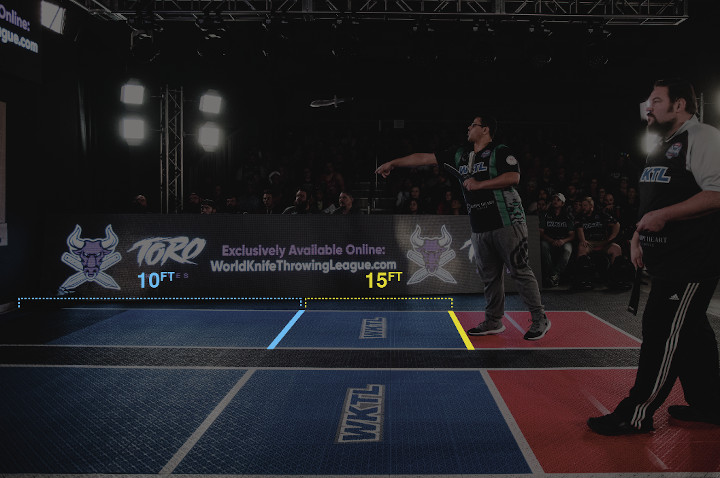
Faults
- A fault occurs when any of the following conditions are met, before both throwers’ scores are verbally expressed by the Judge:
- a thrower’s foot crosses the respective fault line.
- any other part of the thrower’s body touches any part of the lane, equipment, or building, past the respective fault line and towards the target.
- A set of throws may not begin without a verbal or gesture signal of an open lane from the presiding Judge and confirmed by all throwers. If no signal is given or confirmation received, and a throw is made by a thrower, then that throw will count as a fault.
- The final throw of a set must be taken within 10 seconds from the opposing thrower’s final knife thrown in their set. Throws after 10 seconds of the opponent’s final knife coming to rest, will result in a throw fault.
- Example: If one thrower has finished throwing their set of 3 knives before retrieval and the opposing thrower has not after 10 seconds of the final knife, the remaining knives of that set are counted as faults.
- During a set of throws, throwers are notified of faults directly after the offending throw.
- When a fault occurs during a set of throws, the offending throw will be marked as a fault in the app, resulting in a score of 0 for that throw.
- In the case of a fault outside of a set of throws, it will result in the highest scoring knife in the set scored as a fault.
- If additional faults occur, the offending throwers second highest scoring knife is scored as a fault, etc.
- In the case of additional knives being thrown outside of the standard set of throws (described in Section C.2.b.i-iii), all additional knives thrown will count as a fault resulting in the highest-scoring throw on the board will also be marked as a fault (one fault per additional knife).
Section D: Scoring
Points
- Point Rings:
- 1 point for the outermost ring.
- 2 points for the 2nd outermost ring.
- 3 points for the 3rd outermost ring.
- 4 points for the 4th outermost ring.
- 5 points for the 5th outermost ring.
- 6 points for the bullseye.
- 8 points for the Killshot.
- Knives must be touching the scoring area to count for a point value. See Section D, Technicalities, 2.
- The black ring outlining the scoring area counts as the lower scoring area.
- The outline surrounding Killshots and Bullseyes is a valid scoring area. See Section H, Target Design for more information.
- If a knife falls out of the target before the presiding official scores the knife, the knife is counted as a drop.
- Killshot Throw
- The Killshots are active for any throw during the 10 throw match, but must be called prior to the throw,
- Before throwing for the Killshot, the player must make clear to the Judge and their opponent that they intend on throwing for the Killshot.
- A player may not change their call once the judge confirms the intent to throw for a killshot.
- A player may call a kill AFTER their opponent has thrown
- During a match, both throwers may call up to 2 Killshots at any time during the regular 10 throw match.
- In the event a thrower scores 2 Killshots, no further Killshot (8) points are awarded unless that thrower has a drop, at which time the thrower is allowed to call a 3rd Killshot
- Once a thrower hits a Killshot during the match, that Killshot cannot be attempted again until the opposite Killshot is hit. A hit Killshot(s) does not reset until;
- the opposite Killshot is hit
- the game enters into sudden death (OT)
- the game is completed
- If a Killshot is attempted but missed, the thrower may throw for that Killshot again.
- In the event of a drop during any throw (except the 10th), the thrower who dropped may attempt to score one additional Killshot.
- If the thrower has already hit both Killshots, they may select to throw at either Killshot.
- A drop must be correctly recorded in the app and the match to allow a 3rd Killshot attempt.
- If the thrower has already hit both Killshots, they may select to throw at either Killshot.
- Example: If a thrower has scored their 2 Killshots in the regular match and a drop occurs on the 7th throw, they are eligible to score a third Killshot on any of the remaining throws of the regular match.
- If the thrower does not indicate that they are making a Killshot attempt, the Judge will assume it will be a standard throw (a non-Killshot attempt)
- If the Killshot is called, but the player’s knife does not hit the Killshot, then no points are awarded.
- If a player hits a Killshot that has been hit previously, a closed Killshot, no points will be awarded
- The Killshots are active for any throw during the 10 throw match, but must be called prior to the throw,
- Sudden Death
- In the event of a tie after 10 throws in a single game, the game enters into sudden death.
- Points are not counted or tallied during sudden death.
- Only Killshots are active during all sudden death throws.
- Both killshots are open for the entirety of sudden death, regardless of any hits.
- Sudden Death throws are taken from the 15ft line.
- Throwers will remain at their respective targets for sudden death throws (no switching of targets required).
- Sudden Death consists of up to three knives, thrown in the thrower’s best effort to hit the killshot.
- Each set of 3 throws in sudden death consists of one knife thrown by each thrower.
- Knives are not retrieved in between sudden death sets (unless additional rounds are required after throw 3 of the set)
- If one thrower hits a killshot while their opponent misses in any round of sudden death, that thrower is awarded the win.
- If both or neither thrower hits the killshot during the first two rounds of sudden death, sudden death continues.
- Each set of 3 throws in sudden death consists of one knife thrown by each thrower.
- Unless a player is awarded the win for a hit killshot in throws 1 or 2, Sudden Death ends after round 3.
- If neither or both players hit the killshot on throw 3, a measurement will be made to the single closest knife which missed the killshot for each thrower.
- A measurement will be done by the presiding official to determine the closest knife to the killshot and the thrower with the shortest distance between one of the thrown knives on the board outside of the killshot will be determined the winner.
- Any dropped knife or knife stuck outside the traditional target boards (the wall, headers, footers, etc.) will be considered to be 15′ from the killshot.
- If a thrower touches a knife in the target before a measurement is made, the match is awarded to the opposing thrower.
- Additional Sudden Death sets will be had based on the following criteria:
- If measurements are inconclusive, resulting in a tie.
- If all three knives are in the killshots by both players.
- If all knives thrown result in a drop by both players.
- In this case scenario, throwers will throw all subsequent sudden death sets are thrown from the 10′ line. Otherwise, they follow the same rules as sudden death above.
- If a thrower touches their knife before a measurement is made and the judge signifies they are allowed to retrieve, the match is awarded to the opposing thrower.
- In the event of a tie after 10 throws in a single game, the game enters into sudden death.
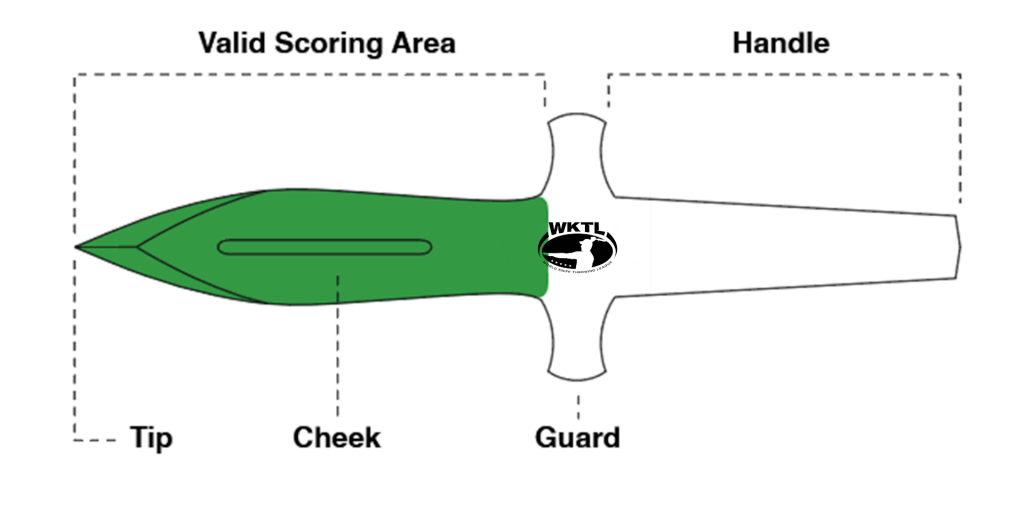
Technicalities
- Scoring Area of Knife
- The scoring area will be the knife tip and the knife edge but not the handle or past the guard.
- The tip of the blade must be in the board for the score to count.
- For example, if the knife is embedded by the cheek only, and the tip is not embedded past the surface of the wood, the throw is scored as a 0.
- If the guard of the knife is making contact with the target (on the intended scoring plane of the board), the score does not count.
- If the knife tip is embedded past the surface of the wood, but the guard is also touching the wood target, the throw is scored as a 0.
- For example, if the knife is embedded by the cheek only, and the tip is not embedded past the surface of the wood, the throw is scored as a 0.
- The tip of the blade must be in the board for the score to count.
- The tip of the knife is the point of the valid scoring area that is the farthest from the end of the handle (or pommel)
- There can only be one tip of the knife.
- The scoring area will be the knife tip and the knife edge but not the handle or past the guard.
- Touch (touching)
- Knives only need to touch the scoring area to count for that value.
- Defined as when the scoring area of a knife is embedded in the scoring area of the target.
- If the scoring area of the knife touches multiple sections of the target simultaneously, the thrower is awarded the points for the higher valued section.
- Touching the scoring line will not give you the higher point value, the scoring area of the knife must be touching inside of the scoring ring.
- For example: touching the black line of the 5 ring is scored as a 4. Touching inside the 5 ring (touching unmarked wood) counts as a 5.
- Knives only need to touch the scoring area to count for that value.
Tallying Scores
- When all knives are resting in their final place, before retrieval, they will be scored.
- The points from the knives will be determined by where the closest scoring area of each knife blade meets the surface of the wood that the knife blade is embedded into before retrieval.
- All scores must be verified by a presiding official or Judge. If a presiding official is also competing in the league then their scores must be verified by another third party. No thrower regardless of position in the venue or WKTL® may submit scores for themselves without verification from a third party.
- If a thrower touches any part of their opponent’s knives at any time during a match without permission, their total match score will be brought to zero and the match will be forfeited.
- Once a knife is scored, the presiding Judge may ask the thrower to remove the first scored knife to determine the score of another knife. If removing the first knife causes the other knife to drop, the lower score threshold will be given.
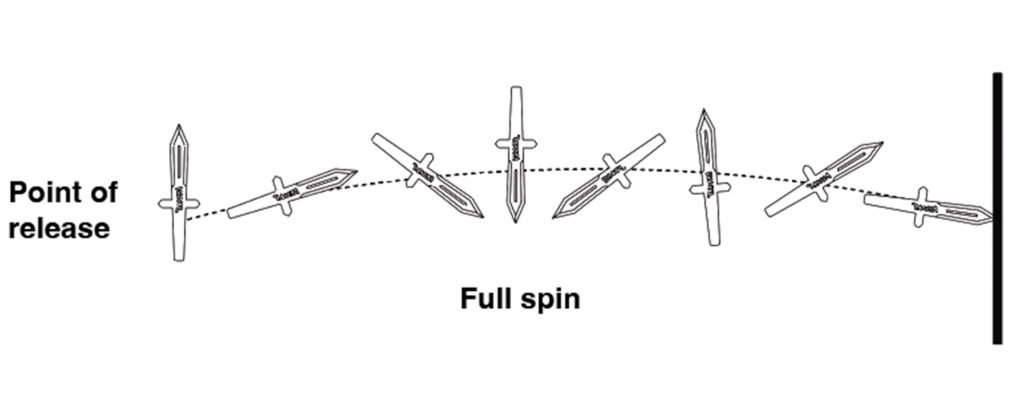
Section E: Attendance
Late Throwers and/or Early Departures
- Venues will provide a minimum 15 minute grace period for throwers to arrive, after the official league start time.
- If a thrower arrives later than the time allowed as established by the venue, each game that they miss will be awarded to their opponent, and the opponent will still throw the match for a score. The missing thrower will receive a 0 for each throw in the match(s).
- If a thrower leaves before all their league night matches are completed, it is at the venue’s discretion to:
- allow the thrower to make up the game the next league night they are in attendance.
- award their opponent the win, and the thrower that left receives a 0 for each throw. The opponent will still throw the match for a score.
Tournament / Playoff Exceptions
- Throwers are required to arrive and check in by the start of regulation play.
- If a throwers is not present when their match begins, a 10 minute grace period will be offered.
- If the throwers does not show up, they will forfeit their match and the throwers that is present will be awarded the win.
- If the player arrives during their grace period, but is late for their next match, they will be immediately disqualified.
Absences
- Throwers are allowed to make up any amount of missed matches during regular league nights, but all matches must be made up by week 7. Matches that are not completed at the end of week 7 will not be recorded as played.
- Any matches that are pre-thrown, or made up, MUST be completed during the regular league night. Matches CAN NOT be pre-thrown, or made up, outside of the regular league day/time.
- All matches that are made up, or pre-thrown, will be subject to the single thrower and manual matching rules defined herein.
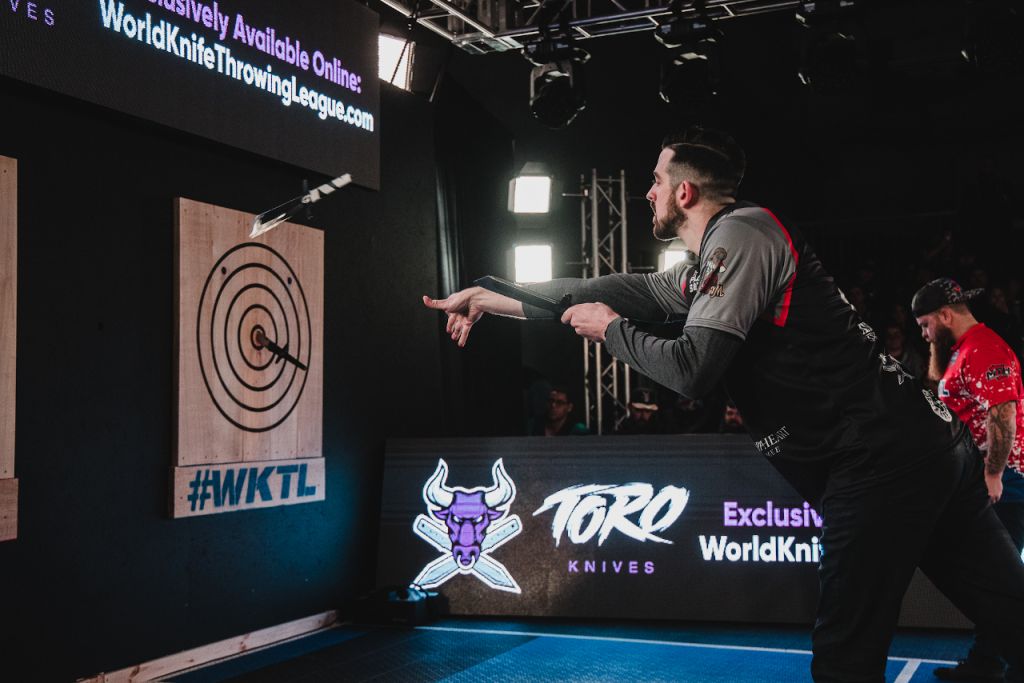
Section F: Misconduct
- Purposeful Distractions are defined as, but not limited to: Excessive celebration, taunting, using abusive, threatening, or insulting language, trash-talking, stepping in the lane during a throw, excessive noises, offensive gestures to opponents, or any purposeful distractions with the intent to distract a thrower during a league match or tournament round will not be permitted during games.
- First Offense:
- The first purposeful distraction from an opposing thrower will result in a zero score for that throw, for the thrower causing the distraction.
- The first purposeful distraction from a spectating league member or tournament participant will result in a zero in the first throw of their next match.
- The first purposeful distraction from a spectator not participating in the event will result in the immediate removal from the facility.
- If the first purposeful distraction is a gross violation, intended to either save the player from a loss, intimidate the opposing player, or be an act of aggression against the opposing player or Judge, WKTL® or the presiding Judge may elect, at their sole discretion, that the player causing the purposeful distraction to be removed from the tournament, league and/or facility.
- Second Offense:
- The second purposeful distraction from an opposing thrower will result in a forfeit for that match. Zero scores will be entered for the full match.
- The second purposeful distraction from a spectating league member or tournament participant will result in a forfeit from their subsequent match. Zero scores will be entered for the full match.
- Third Offense:
- The third purposeful distraction from an opposing thrower will result in a forfeit of the season for league play or forfeit from the tournament. The thrower will not be allowed to throw or spectate for the remainder of the season or the remainder of the tournament.
- The third purposeful distraction from a spectating league member will result in a forfeit of the season or tournament. The league member or tournament participant will not be allowed to spectate or participate for the remainder of the season or tournament.
- Match Fixing & Sandbagging in League Play or Tournaments:
- If any thrower is found to fix a match to achieve a desired outcome, during league play or tournaments, then that thrower will be banned from all WKTL® tournaments & leagues. The thrower may appeal the ban, one year after the offense, pending review by the Commissioner.
Procedures and Specifications
Section G: Lanes
- Each throwing area is designated as a throwing lane.
- A regulation lane for competition must contain 2 targets.
- Fences or walls block this area from the rest of the facility to keep throwers and knives all contained in a safe environment.
- Only the two participating throwers and the knife throwing Judge are allowed inside the lane at one time. This includes ensuring the area behind the throwers is clear of any other person up to 5′.
- 10 ft minimum/clear ceiling height (within the throwing lane) is recommended for safety reasons.
- It is recommended for a lane to be a minimum of 12ft in width with the targets evenly distributed.
- It is recommended for a lane to be a minimum of 18ft in length to accommodate for a 15ft fault line and safe space to throw.
- It is recommended that fault lines be 3 inches wide and that the fault be measured from the front of the target to the back of the line; if throwers step into/past the line, it is a fault.
- This is guidance from WKTL® and is the sole discretion of the venue to create fault lines as they wish.
Section H: Targets
Building a WKTL® Target
- Each Target should be made of 3 layers of wood.
- The first layer should cover the wall in OSB or plywood.
- The second layer is called the Backboards and should be made of wood.
- There should be horizontal 2x10s, that are 4′ feet long, drilled into the wall, and packed tightly together to cover the full space for the outer Targets. (This usually takes 6 – 8 boards) This will be the backboard where you will then drill your target boards against.
- The third and outermost layer is called the Target boards. These are also made of 4′ feet long 2×10 lumber. The targets consist of two components: 1) the targets 2) the headers and footers.
- End grain targets are allowed, providing they meet all target design measurements and specifications.
- Approximate Measurements for the 2×10 boards:
- U.S: Thickness:1-1/2 in • Width 9-1/4 in • Length 4 ft.
- Metric: Thickness 38mm • Width 235 mm Length 1.22m
- A variance of these measurements is allowed. WKTL® does not enforce the exact thickness or width of boards, rather, the proper and accurate size of target specifications.
- They should be arranged just like the example picture below.
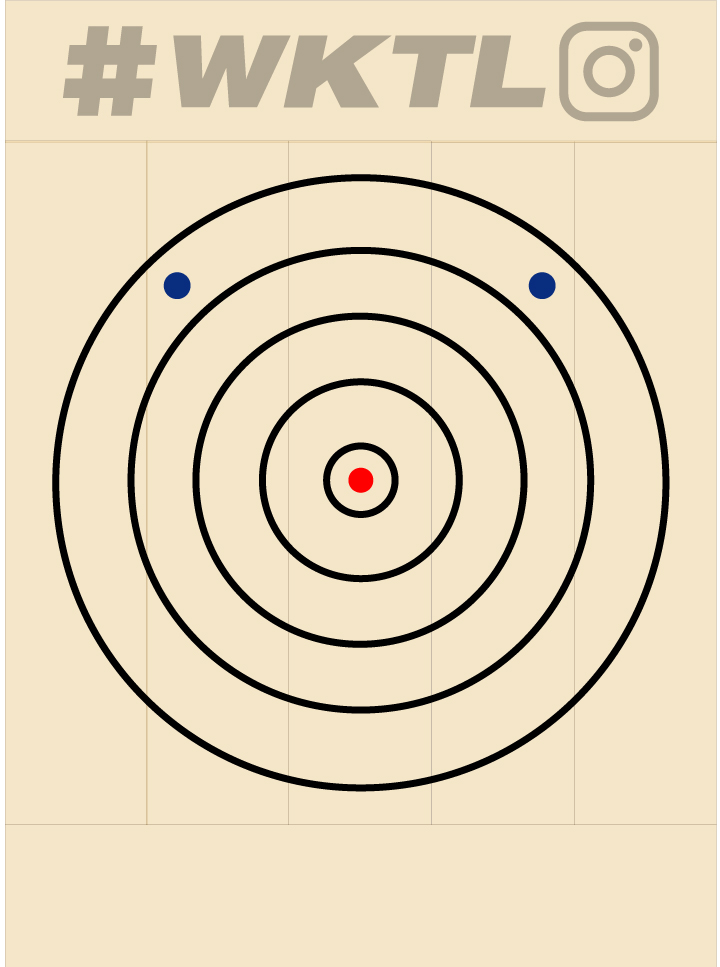
Headers and Footers
- Above and below the targets, venues will install headers and footers. This will help protect the top and bottom areas of the target while allowing for the branding of your company.
- Header: drill one 4′ foot long 2×10 piece of wood horizontally on top of the target against the backboard.
- Footer: drill one 4′ foot long 2×10 piece of wood horizontally on the bottom of the target against the backboard.
- The footer also provides the benefit of allowing you to change boards quicker and easier.
- The top of the footer should be 36 inches off the ground.
- The end product is a backboard that is 4′ feet x 6′ and another layer of wood that fully covers the back at 4′ feet x 6′ as well.
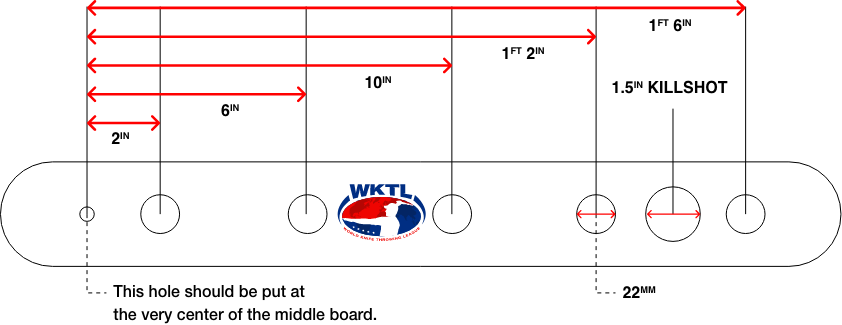
Target Design
- Each WKTL® affiliated location shall purchase an official target protractor/stencil.
- The small hole on the left will have a screw that will be drilled through it into the center of the middle board. (Approximately 24 inches in the center of the board. That will make 60 inches from the floor).
- A black, 20mm marker will then be used to draw the remaining circles.
- Holes are 22mm thick to allow for a marker to fit that has 1/2″ thick felt.
- Lines are to be 20mm thick.
- The bullseye is to be colored in red and outlined with a black, waterproof pen.
- The entire bullseye area (inner red circle and unmarked 5 ring) must be 3.5” inches in diameter inside the center ring. The center of the bullseye must be 24” inches (60.96 cm) from the bottom of the board. This should make the bullseye 60″ from the floor.
- The inner bullseye (inner red circle) should be 1.5” in diameter, outlined with a black, waterproof pen.
- The inner bullseye must have a black outline using a ballpoint pen which will count as a scoring area, but any red that bleeds outside of the black outline will not. To gain points for the bullseye, the knife must touch red or black if inside of the black outline.
- The Killshots (2 blue circles) are 1.5” inches in diameter and positioned inside the 1 point ring.
- The bottom of the Killshot is positioned approximately 35.25 inches from the bottom of the board and 2.5 inches from the outer side of the board ensuring they are centered inside the 1 point outer ring.
- Killshots are to be outlined using a red waterproof ballpoint pen that clearly denotes the Killshot, eliminating overspray or bleeding caused by markers. The red outline of the ballpoint pen will count as a scoring area, but any blue that bleeds outside of the red outline will not.
- All targets must be level (no slanting of the targets is allowed).
- Targets will have no marking other than the lines, bullseyes, and Killshots.
- “#WKTL” or #WATL is required to be listed prominently on either the header or footer boards.
- For knife throwing tournaments, #WKTL will be shown.
- WKTL® requires proper lighting insofar as boards can be seen clearly from behind the throwers.
- Projected Targets are not WKTL® compliant. Only boards with physical markings are permitted.
Section I: Knives
- Throwing knives must be at least 13.5 inches and may be no longer than 16 inches.
- This is to be measured from the tip of the knife to the opposite end of the knife in a straight line.
- Throwing Knives can have an allowance for a minimum length of 13 inches due to natural wear and tear
- i.e. Chipped tip of the blade or similar equipment wear & tear
- All knives must have guards that are at least 4 inches in width.
- This helps ensure that knives are not able to ricochet off the target and through the fencing at existing facilities. No exceptions.
- The cheek of the knife may be a maximum of 2.5 inches wide.
- There may only be one tip of the knife.
- No throwing stars or multiple tipped knives.
- Max Handle Length can be no more than 7 inches from the bottom of the handle to the guard.
- Minimum thickness 0.1875 inches (3/16) or 4.7 mm
- This requirement does not apply to the sharpened areas defined 9.a.i-ii below.
- The maximum weight of a knife must be no more than 1.65 lbs. (26.4 oz)
- WKTL® approved knives that meet all of the knife specifications listed here in Section I are legal for use in official league play.
- Knife modifications are accepted and allowed as long as all modifications meet the outlined specifications above in Section I and the guidelines listed below:
- Sharpening
- Knife blades may be sharpened or thinned and profiled within 4 inches from the tip. The factor bevel need not be identifiable in this area.
- Knife blades may be sharpened along and up to the limits of the existing factory bevel which extends further than 4 inches away from the tip. The existing factory bevel limits must be identifiable in this area.
- In the case that the knife blade shape, size, thickness or surface is modified (see 9.d.i), knife blades may be sharpened along and up to the limits of the remaining existing factory bevel which extends further than 4 inches away from the tip. The remaining existing factory bevel limits must be identifiable in this area.
- Cosmetic alterations
- Etching, engraving, coloring, etc…of the knife is allowed.
- Handle alterations
- Adding leather, wood, cut-out holes, synthetic scales, or other materials to the handle is authorized as long as it meets all other above specifications.
- All additions to knife handles must be securely attached to the knife.
- Shape, size, thickness and surface alterations
- Changes to the shape, size, thickness and surfaces are allowed to the blade, guard and handle as long it meets all specifications above and the prohibited modification guidelines below.
- Prohibited modifications:
- Re-forging the knife to change the shape, size, thickness and/or surface.
- Cutting the knife apart and welding it back together to change the shape or size of the knife, or the position of guard
- Adding material to or reforging the blade to make the blade meet the maximum width.
- Sharpening
- Knives may be inspected at any time to ensure they meet WKTL® Specifications.
- If knives fail to meet WKTL® Specifications, the knife will be considered non-compliant with WKTL® standards and not allowed for league or tournament use.
- Broken Knives
- If the Judge determines that a thrower’s knife has broken during a set. The thrower must provide a replacement knife to be verified and approved by the Judge.
- If they do not provide another non-broken knife within 90 seconds, the current throw will count as 0 points.
- If a thrower has a broken knife, they may continue with any remaining throws which will be scored by the Judge.
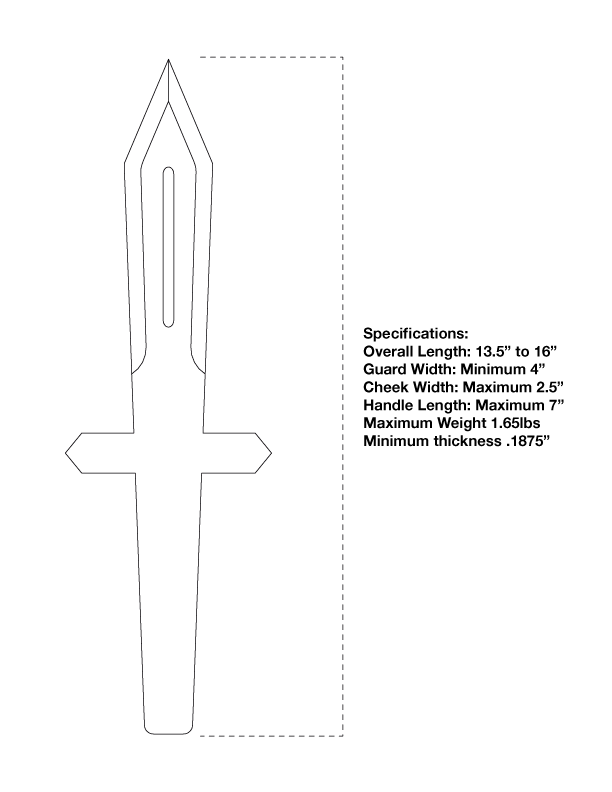
Section J: Judging
- A Certified Judge must always be present while members are throwing during league play. Judges must verify all scores taken for official league play.
- A 5′ radius should be maintained around every participant holding a knife, however, the judge may approach the participants and enter this 5′ radius to provide instruction.
- After a call is made by the lane Judge, throwers may request a second opinion from the residing Head Judge or, if a Head Judge is unavailable, another certified judge.
- The second opinion is the final call and can not be disputed further.
- If a thrower touches any knife in their target before a second opinion call is made, the original score given by the first Judge stands.
- While a second opinion is being discussed, throwers must return behind the 10 ft fault line.
- Judges will not be, or become, under the influence of any alcohol or substance during any time they may reasonably be expected to Judge matches. If it is suspected that a Judge is under the influence, then they must be removed from judging immediately and may be subject to removal of their certification.
- Certified Judges:
- At least 1 Certified Judge per 16 throwers is required to be present for WKTL® Leagues or Tournaments
- There must be at least 1 Certified Judge for every lane scored for televised tournaments, including the World Championship.
- Certified Judges must be actively working sanctioned events to count towards the Judge requirement minimums. Participating throwers who are Certified Judges, but are not actively working the event, are not counted towards this minimum requirement.
- Certified Judges are allowed to participate as throwers but may never score their own matches.
- Judges should not preside over sanctioned games where there is a conflict of interest unless the circumstances are unavoidable. Conflicts of interest would include – family members, significant others, etc.
- Judges are responsible for disclosing any conflicts of interest before a sanctioned game and recusing themselves. A replacement judge must be found before the game may begin.
- Should there be no available options the judge is responsible for disclosing the conflict of interest to the thrower and the circumstances are unavoidable.
- Throwers can request another Judge if a conflict of interest is present.
- Any incorrect applications of rules made in situations where bias may be present could lead to the removal of certification.
- Judges are responsible for disclosing any conflicts of interest before a sanctioned game and recusing themselves. A replacement judge must be found before the game may begin.
- Judges will not take advice, second opinions, or consultation from any throwers or spectators.
- Any throwers found to be persuading or advising an official Judge will receive a Code of Conduct violation.
- If another Judge or thrower believes that a Judge is not following current rules and regulations or is making incorrect calls, they must report it directly to a Head Judge or persons in charge of running the tournament immediately.
- Any gross misconduct from Certified Judges may be reported to wktl@worldknifethrowingleague.com.
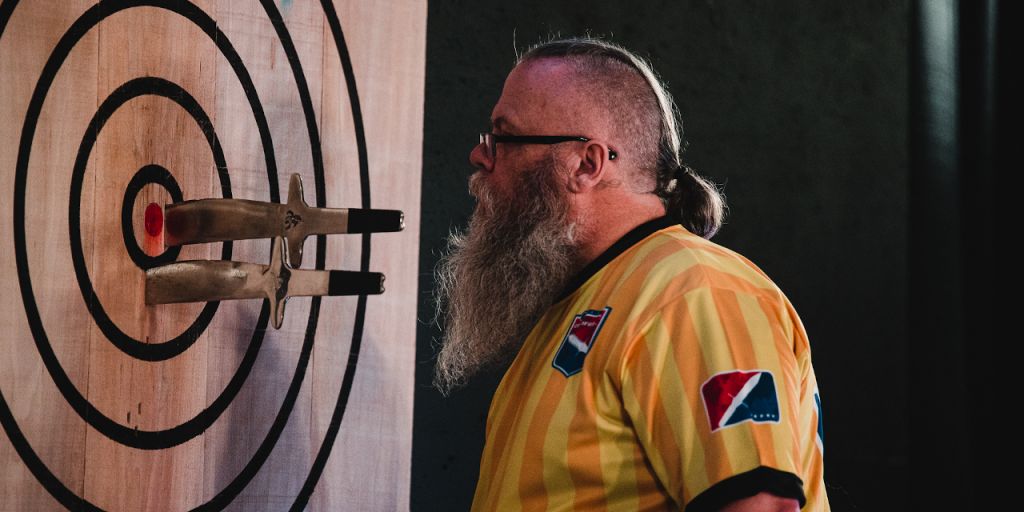
Section K: Regular Season
- A WKTL® Sanctioned League must have a minimum of 4 different throwers with at least 12 games played in the league season.
- The entire season lasts 8 weeks including playoffs.
- Sanctioned League
- A Sanctioned League is the knife throwing league hosted at a participating WKTL® affiliated venue that follows the rules and regulations of the World Knife Throwing League®.
- If Sanctioned League requirements are not met, the league will be considered a Recreational League.
- WKTL® must be notified at least 2 weeks in advance, before the end of the season, of delays to the end of a season due to acts beyond the reasonable control of the venue.
Multiple Sanctioned Leagues
- A WKTL® affiliated venue may host more than one sanctioned league per season.
- Each additional league a venue hosts must meet the minimum requirements for throwers, not counting throwers that are participating in another league at the same location (not including Marathon League Throwers).
- Throwers already participating in another sanctioned league at the same venue do not count towards the minimums.
- Marathon leagues are excepted from this rule, and throwers participating in marathon leagues may also count towards a regular league minimum.
- Throwers may participate in as many sanctioned leagues as they wish, but only one league will be considered for World Championship eligibility.
- Throwers participating in multiple sanctioned leagues must use the same profile and Player ID to compete in all leagues.
Marathon Leagues
- Marathon Leagues may be held anytime during a WKTL® League Season.
- Venues may host a maximum of two Marathon Leagues in any given season.
- A Marathon League is an officially sanctioned WKTL® league as long as it meets the following requirements:
- A Marathon League is a league that is held, in its entirety, over 24 hours.
- It must be labeled using the following naming convention: “[Venue Name] [League Night] Marathon League” when creating the League in the WKTL® app.
- The additional sanctioned marathon leagues follow the same rules regarding multiple league participation as detailed in Section K: Multiple Sanctioned Leagues above.
- Players may compete in multiple sanctioned marathon leagues in the same season.
- All rules regarding regular season play, playoffs and qualifying apply.
Section L: Playoffs
- During the League Playoff (Week 8) tournament all league members will have the opportunity to participate in a double elimination bracket.
- Venues will have the opportunity to choose a single game, or best 2/3 format for Week 8 tournaments.
- Seeding is done based on the total match wins from weeks 1 through 7.
- In the case of a tie for match wins the seeding will be based on the total points gained during weeks 1-7 between the two tied throwers.
- All competitors eligible for playoffs will be put into two sets of brackets, the winner’s bracket and underdog bracket (A and B brackets for short) after the first round. The first-round winners proceed into the A bracket and the losers proceed into the B bracket. The A bracket is conducted in the same manner as a single-elimination tournament, except that the losers of each round “drop down” into the B bracket.
- The final Championship round is between the winner of the A bracket and the winner of the B bracket consisting of best of 3 matches. Allowing for one practice throw between each match.
- The Winner: will be the person who wins 2 out of the 3 matches first.
- The A winner must lose twice for the B winner to win the Championship.
- This means that if the B winner beats the A winner in a best of 3 matches, they must play another best of 3 matches for the B winner to win the Championship.
- The Winner: will be the person who wins 2 out of the 3 matches first.
- For WKTL® sanctioned tournaments, bracket tie breakers will be determined by the average bullseye hit percentage in the tournament.
- For example, in a tournament, if throwers A & B are tied in 5th and 6th place, the thrower with the highest average bullseye percentage hit will be in 5th place and the subsequent thrower will be in 6th place.
Section M: Sanctioned Tournaments
- WKTL tournaments are categorized as Bid Tournaments (sanctioned) and Non-Bid Tournaments.
- Bid Tournaments (tournaments that offer bids directly to WKTC) must adhere to the following requirements:
- Minimum of 16 throwers for standard WKTL
- Minimum of 6 teams for WKTL Duals (if hosting)
- At least 1 Certified WKTL Judge per 16 throwers
- Prize pool payout is a minimum of 40% of entry fees
- Non-Bid tournaments are not required to adhere to the requirements above, but are encourage to do so
- WKTL Tournament Seeding
- WKTL Standard
- Seeding is based on a rolling average of the previous year as well as any completed seasons from the current year.
- Those with no data will be given a seeding placement at approximately the 25th percentile.
- WKTL Duals
- Seeding is based on a rolling average of the previous year as well as any completed seasons from the current year.
- Teams with no Knife Duals averages will use Standard Knife averages to determine seeding average.
- The Knife averages of both teammates will be combined as an average minus 5.
- If teammates do not have current-year averages for Knife, data from the previous year will be used.
- If only 1 teammate has Knife average data, the team will be seeded by that teammate’s average minus 5.
- Teams with no team data and throwers with no WKTL standard data will be given a seeding placement at approximately the 25th percentile.
- WKTL Standard
The World Knife Throwing Championship®
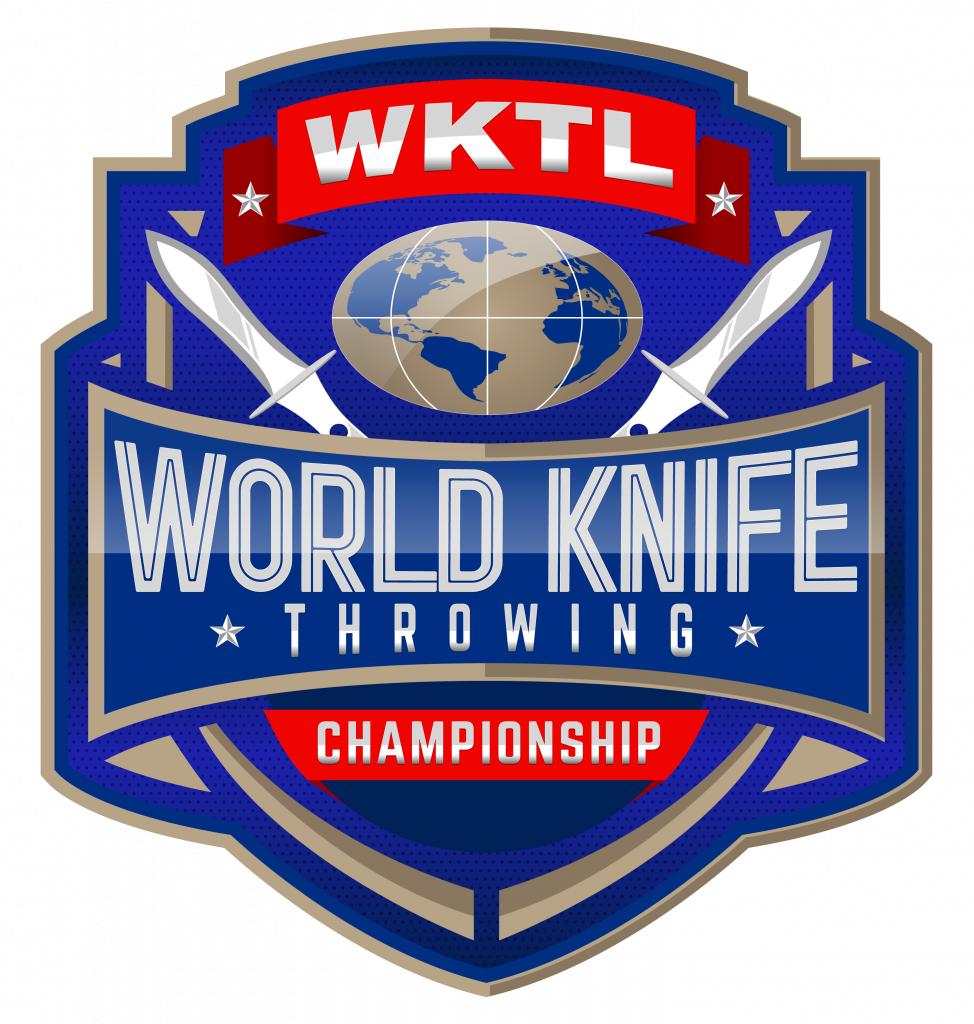
Section N: Qualifying
The World Knife Throwing Championship® will be comprised of 128 competitors:
1 WKTC Champion from the previous year
20 Top Leaderboard Throwers Per Season
32 Bids from Open Qualifiers
15 Bids will be awarded to WKTL® tournaments throughout the year
- The number of bids may change based on participation.
- Bids stemming from leaderboard points are based on a single season or tournament
- Scores for participants who have already earned a bid will not be considered to qualify for bids.
- Leaderboard (seasonal and tournament) bids will be passed to the next qualified thrower.
- Leaderboard ties will be decided by:
- a throwers number of bullseyes hit in the season.
- If there is still a tie, by a throwers number of hit Killshots in the season.
- Scores for participants who have already earned a bid will not be considered to qualify for bids.
- For WKTL® sanctioned tournaments, bracket tie breakers will be determined by the average bullseye hit percentage in the tournament.
- For example, in a tournament, if throwers A & B are tied in 5th and 6th place, the thrower with the highest average bullseye percentage hit will be in 5th place and the subsequent thrower will be in 6th place.
- Any remaining bid placements that can not be allocated will be added into the open qualifiers.
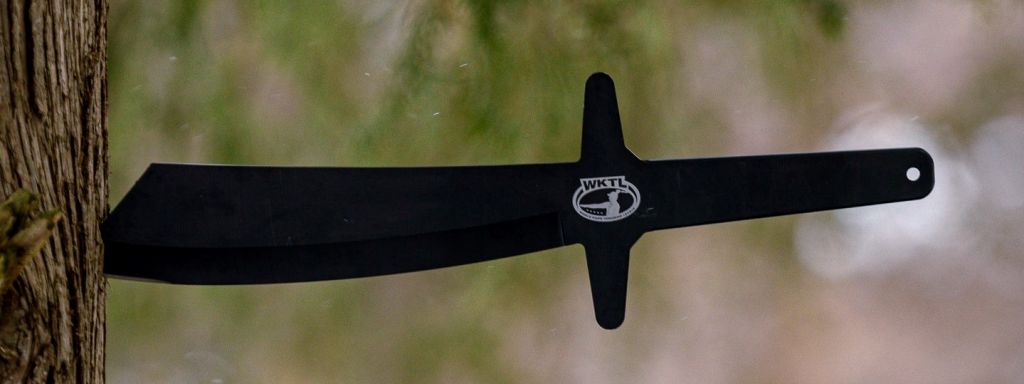
Section O: WKTL Duals
Duals is a partnered competition where two competitors each throw their standard knives simultaneously at the same target from a distance of at least 10 feet from the shared target.
Standard WKTL® Gameplay, Regular Season, Playoff, and Qualifying rules apply with the exception of the below additions/changes:
- Throwers on a duals team must throw each knife in unison with their partner (fault rules for failing to do so apply)
- Each game consists of 5 throws per player, per game minimum.(a total of 10 thrown knives)
- These 5 throws are broken into two sets of throws. Knives are retrieved after the first set of 3 throws and after the second set of 2 throws.
- The first set consists of throwing 3 knives is thrown at 15ft
- The second set of 2 knives at 10ft.
- Teams will switch sides after each game but will remain on the same target for the duration of each game.
- Duals Killshots:
- Killshots are able to be active for any throw in a game but must be called to activate them.
- Before throwing for the Killshot, the player must make clear to the Judge and their opponent that they intend on throwing for the Killshot.
- This is referred to as “calling the Killshot” and activates it for the full 8 points.
- The player cannot change their call once a Judge confirms the intent to throw a Killshot.
- Before throwing for the Killshot, the player must make clear to the Judge and their opponent that they intend on throwing for the Killshot.
- Each team receives 2 Killshots per game.
- Killshots are assigned to a team. Either of the two teammates may take both the Killshots, or they may take one each. Killshots are not limited to 1 per individual.
- 1st and 2nd Killshots for the team must be alternated if hit. Unless both throwers throw for the same killshot on the same throw. If a thrower hits a Killshot during the game, that Killshot cannot be attempted again until the opposite Killshot is hit. The opposite being defined as the left Killshot (if the right Killshot was hit) or the right Killshot (if the left Killshot was hit). This alternating approach persists through any lane changes by players in the current game.
- A single thrower may still throw both Killshots, but they must alternate either throwing cross lane, or switching sides with their partner. Once a thrower hits a Killshot during the game, that Killshot is “closed” and does not reset until:
- the game enters into sudden death (overtime)
- or the game is completed
- Once a Killshot is hit, it is considered closed. If both teammates throw for the same Killshot and both hit it, both killshot attempts afforded to the team will be used.
- A third Killshot attempt will not be awarded for any drops during Duals throwing.
- Killshots may be called after your opponents have thrown their knives
- Killshots are able to be active for any throw in a game but must be called to activate them.
- All sanctioned Duals tournaments will consist of a best 2/3 games.
- Venues can choose if Week 8 matches consist of a single game or a best 2/3 game format for their Week 8 tournament
- If there is a fault by either thrower, the team is penalized with a fault and both throwers will receive a zero for that throw.
- A fault occurs when any part of the thrower’s body touches any part of the lane, equipment, or building past the fault line, toward the target, before both players’ scores are verbally expressed by the judge.
- A fault occurs if one teammate throws their knife and it hits the target before the other teammate has let go of their knife.
- As a safety precaution players must stand at approximately the same distance for the duration of the throw.
- One player cannot stand at the 10ft line and another at the 15ft line as it introduces a potential risk during the throw
- Players must stand side-by-side with each other, at the same general distance, or if stepping towards the target to throw, their motion must generally be in unison.
- Once a knife is scored, the presiding Judge may ask the thrower to remove the first scored knife to determine the score of the second knife. If removing the first knife causes the second knife to drop, the lower score threshold will be given.
- For a knife that is embedded into another knife (a Robin Hood), both knives will receive the points of the first knife embedded in the target.
- Sudden Death:
- If there is a tie a game, the game enters into sudden death.
- Sudden Death throws are made from 15ft.
- ONLY Killshots are allowed during all sudden death throws.
- If all players hit the Killshot, an additional sudden death throw is required.
- Teams will remain in their respective targets for sudden death throws (no switching of targets or Killshots required).
- If all players miss the Killshot during Sudden Death, a measuring tape or accurate measuring device will be used to measure the distance from the closest valid scoring area of each knife head to the closest edge of the Killshot.
- The single knife with the shortest distance on either team will be awarded the game in favor of the team who threw it.
- If one player from each team hits the Killshot and the other players on each team miss, a measuring tape or accurate measuring device will be used to measure the distance from the closest valid scoring area of each knife head, that missed the Killshot, to the closest edge of the Killshot
- The single knife with the shortest distance on either team will be awarded the game in favor of the team who threw it.
Sanctioned Duals Leagues
- A WKTL® Sanctioned Duals League must have a minimum of 2 different teams (4 unique throwers) to be official.
- Each additional league a venue hosts must meet the minimum requirements for throwers.
- Throwers already participating in another sanctioned league at the same venue do not count towards the minimums.
- Marathon leagues are excepted from this rule, and throwers participating in marathon leagues may also count towards a regular league minimum.
- Throwers already participating in another sanctioned league at the same venue do not count towards the minimums.
- Each additional league a venue hosts must meet the minimum requirements for throwers.
- Duals Leagues follow WKTL® Seasons as outlined in Section K.
Multiple Sanctioned Duals Leagues
- Venues may host more than one Sanctioned Duals League per season.
- Each additional league a venue hosts must include 2 Teams not counting throwers that are participating in another Duals league at the same location (not including Marathon League Throwers).
Duals Marathon Leagues
- Duals Marathon Leagues may be held anytime during a WKTL® League Season
- A Marathon League is officially sanctioned as long as it meets the following requirement:
- A Marathon League is a league that is held, in its entirety, within 24 hours.
- They must be labeled using the following naming convention: “[Venue Name] [League Night] Marathon League” when creating the League in the WKTL® app.
- Meets the minimum thrower requirements as outlined in Section K, iv, b
- Players may compete in multiple sanctioned marathon leagues in the same season.
World Championship WKTL Duals
The World Knife Throwing Championship® will be comprised of 64 teams:
1 Duals World Champion Team from the previous year
10 Top Leaderboard Duals Teams Per Season
13 Bids from Open Qualifiers*
10 Bids will be awarded to WKTL® tournaments throughout the year
- The number of bids may change based on yearly participation.
- *For the first Knife Duals World Championship, there will be one additional Open Qualifier bid as there is no past World Champion to be invited.
- Bids stemming from leaderboard points are based on a single season or tournament
- Leaderboard (seasonal and tournament) bids will be passed to the next qualified thrower.
- Leaderboard ties will be decided by:
- A thrower’s number of bullseyes hit in the season.
- If there is still a tie, by a thrower’s number of hit Killshots in the season.
- Scores for participants who have already earned a bid will not be considered to qualify for bids.
- Any remaining bid placements that can not be allocated will be added into the open qualifiers.
- Any player on a team may decline their World Championship bid for their team at any point by contacting the WKTL staff and notifying them at WKTL@worldknifefthrowingleague.com.
- All declined bids are final with a confirmation from WKTL staff.
- Should a player decline their bid, that player may attempt to earn a bid with a different team or as the same team again for the upcoming World Championship.
- Players will be in consideration for the next bid available after one week from their notification to decline. After that one-week period, they may earn a bid in any manner available to them in the current competition year (including open qualifiers if they are held outside of the calendar year).
Restrictions on Qualifying
- A player cannot compete in multiple Duals teams for any tournament or World Championship. Any player with a bid will not be eligible for a bid on any other team unless they decline their bid as described in World Championship Duals 4.
- Duals teams may participate in as many sanctioned Duals leagues as they wish, but only their highest-scoring league per season will be considered for worlds bids.
- Teams participating in multiple sanctioned events must use the same profile and Team ID to compete in all events.
- If a Duals partner cannot attend WKTC, the Team will automatically decline their bid.
